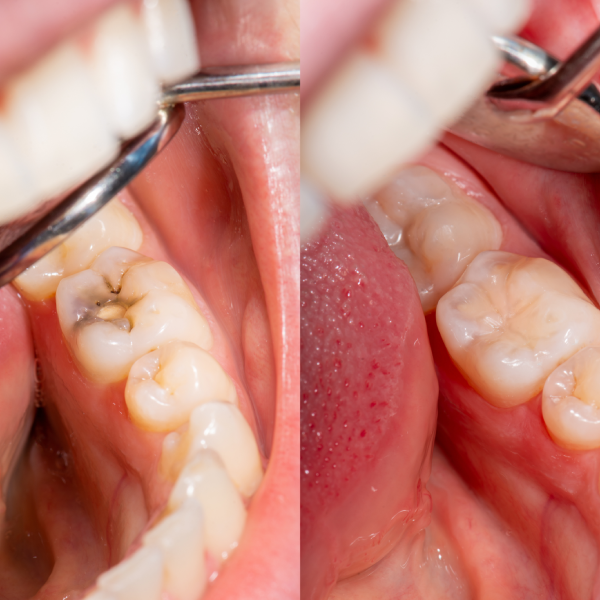
Dental fillings are a routine dental procedure designed to restore a tooth with minor tooth decay. It falls under the category of general restorative dentistry because it can be performed by a general dentist. The team at Glow Up Dentistry offers a variety of procedures designed to restore and improve your smile including dental fillings.
Here is what you need to know about the dental filling procedure.

A dental filling is a dental procedure designed to treat tooth decay and prevent further damage to the affected too. This procedure involves the removal of the decay, which also reduces the risk of pain and infection. An artificial, biocompatible material is used to fill the hole left by the decay.
While there may be some discomfort associated with the procedure, it should not be painful. If you do have moderate or severe pain during the procedure or recovery, contact the clinic.
There are several signs/symptoms that indicate you may need a dental filling, including:

Typically, it takes about 20 minutes to an hour to complete a dental filling procedure, depending on the location of the tooth and the extent of the decay.
The first thing the dentist will do is administer anesthesia. In most cases, a local anesthetic is used. However, we understand that some patients have anxiety, so we will offer sedation options.
Once the anesthesia has taken effect, the dentist will use a drill or a laser to remove the decay. The instrument they use will depend on their training, investment, and comfort with the equipment, as well as the location and extent of the decay.
During the removal process, they will probe/test the area to determine if any decay is still present. Once all of the decay has been removed, the void will be cleaned and disinfected to remove debris and decay. If the decay is near the toot, a liner may be placed to protect the nerve. Finally, the filling material will be used to fill in the hole left by decay removal.


There are several different types of filling materials to choose from, each with its own advantages and disadvantages:
One of the primary advantages of silver amalgam is that they last an average of 10 to 15 years. Plus, they are less expensive than other options. The drawback is the amount of tooth that must be removed, as well as causes a grayish hue and increases the risk of additional tooth damage due to the expansion/contraction of the filling.
The primary advantage of composite resin dental fillings is that the material can be matched to the neighboring natural teeth. The disadvantages are that they cost more than other options and may not be covered by insurance, they don’t last as long, the process may take longer than other options.
The advantages of porcelain or other ceramics are that they can be color matched to neighboring teeth and resist staining better than composite. However, this material is more expensive.
The advantages of gold dental fillings include a longer life expectancy and offers a pleasing aesthetic. The primary disadvantage is the cost- metal, especially gold, can be expensive.
While most dental insurance companies will cover a portion of the cost of dental fillings, they may not cover composite fillings. This is because composite fillings are less durable than other filling materials and may require replacement more often, plus many providers classify composite as a cosmetic dental option.
If you are experiencing the signs and symptoms of a tooth cavity, schedule your consultation with the team at Glow Up Dentistry today. Our team has the experience and expertise to diagnose and treat a variety of dental conditions, including tooth cavities.
In addition to diagnosing and treating dental conditions, we can offer you tips on proper oral care habits to reduce your risk of dental issues in the future.
Our office is conveniently located on Grand Parkway in Richmond. You can schedule your visit by calling the office and speaking to one of our friendly staff members or by visiting our website.
The team at Glow Up Dentistry strives to help patients understand their procedures. After all, understanding them can help patients relax. If you have questions or concerns, please feel free to bring them up. Meanwhile, we’ve answered some of the most common questions about dental fillings below.
The average cost of a dental filling without dental insurance ranges from around $200 to $600. However, patients may pay up to $4,000 depending on a few different factors including the material, the extent of decay and location of the tooth, the number of teeth that need to be filled, the experience/expertise of the dentist, and the location of the dental clinic.
The dental filling procedure may cause some minor discomfort. However, the pain should not be significant. If you do experience severe pain during the procedure or during recovery, contact the clinic for an emergency appointment. You may have an infection or other complication.
Dental fillings are used to restore/repair a tooth that has been damaged by decay. The dentist cleans the decay from the tooth and then fills it with a biocompatible material to protect and support it.
After you get a dental filling, it’s best to wait at least until the anesthesia wears off to eat anything. When you do eat, make sure to avoid foods that are:
Extremely hot/cold
Hard
Sticky
Sugary
Make sure that you chew with your mouth closed and chew on the side that is opposite the filling. Finally, take your time and make sure that you bite/chew carefully.

TUESDAY: 9 AM – 6 PM
WEDNESDAY: 9 AM – 6 PM
THURSDAY: 9 AM – 6 PM
FRIDAY: 9 AM – 6 PM
SATURDAY: 8 AM – 3 PM
SUNDAY: CLOSED
MONDAY: CLOSED